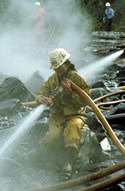 Hardshell clams were devastated during the spill and the following cleanup. At the time of the spill, the push was to remove as much oil as quickly as possible, a difficult task in the remote Alaskan environment. High-pressure washing was often conducted to remove oil from beaches. Although it was unknown at the time, this approach removed the fine sediments from the beach and altered the physical structure or "armoring" of the beach. The initial injury to hardshell clams came with waves of toxic oil mixed in the water, but was then exacerbated by the subsequent pressure washing. The pressurized washing also broke apart the interlocking cobble layers near the surface which protect the fine sediments from storm action. Studies in 2002 found that these early injuries continue as many of these habitats have not recovered. This affects not only clams, but also the sea otters, other animals, and people that rely on clams for food. It now appears that nature will require several more years, possibly decades in some areas, to restore the clam habitat, and thus the clams.
Hardshell clams were devastated during the spill and the following cleanup. At the time of the spill, the push was to remove as much oil as quickly as possible, a difficult task in the remote Alaskan environment. High-pressure washing was often conducted to remove oil from beaches. Although it was unknown at the time, this approach removed the fine sediments from the beach and altered the physical structure or "armoring" of the beach. The initial injury to hardshell clams came with waves of toxic oil mixed in the water, but was then exacerbated by the subsequent pressure washing. The pressurized washing also broke apart the interlocking cobble layers near the surface which protect the fine sediments from storm action. Studies in 2002 found that these early injuries continue as many of these habitats have not recovered. This affects not only clams, but also the sea otters, other animals, and people that rely on clams for food. It now appears that nature will require several more years, possibly decades in some areas, to restore the clam habitat, and thus the clams.
